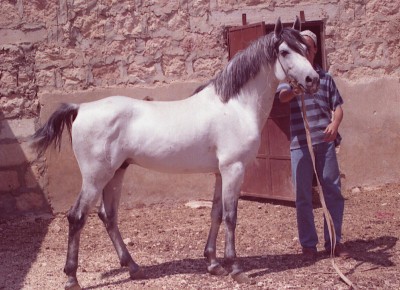Photo of the Day: Ibn Mouna I, ‘Ubayyan Hunaydis from Syria
In the 1990s, Syrian breeder Mustapha al-Jabri, of Aleppo, owned a sturdy, deserty little mare that was bred by the Shammar of Mesopotamia. He name was Mouna, and her strain was very precious: ‘Ubayyan Hunaydis (Lady Anne Blunt: “Mutlaq [her Mutayr stud manager] says mazbut strain”).
She had at least two sons and one daughter by Jabri’s then head stallion Mahrous, a ‘Ubayyan Suhayli – another precoius marbat of the ‘Ubayyan strain. Both sons stood in Jabri’s stallion barn, but I don’t know whether he used them or not. I don’t recall their names, either, and I used to call them Ibn Mouna I and Ibn Mouna II. Below is Ibn Mouna I, with a youthful Edouard in the background.
This horse had some defects, including longer cannon bones and a slightly thicker neck than I’d like, but he oozed real, bold, masculine, desert type. If he could roar he would.

What happened to the sister? I hope that line is still going.
I have enjoyed comparing this photo to the one of Ben Chicao, and while I may be in a minority, this structure seems to me to be closer to what I believe to be Arabian type. The freer elbow and the tighter coupling stand out to me. I don’t want to say that the sloping croup shown in the photo of Ben Chicao bothers me, because it doesn’t. I don’t like a “table top” horse personally. Never met a comfortable riding table. Many still photos fail to capture that area properly, anyway, and the muscling in that area changes with maturity, IMO.
The line is still going. I agree that these two do look like each other, which is I why I blogged about them in a row.
I am delighted to hear the line is still going, and look forward to seeing some further represetatives pictured here. What an archive of information and photos this blog represents!
He has a beautiful color.
very originally.
Would I like to use for breeding.
Long cannon bones and thick neck notwithstanding, he could come sleep on my couch any day. I love his coloring and expression.
I think the heavier neck can be a bit of an aesthetic preference. Usually, such a neck has two features admired: one is considerable strength in movement, the other is a feature that Danah Al Khalifa described, the ability to endure hardship. She gives the old Bedouin analogy to the fat tail sheep and camel of the desert both of whom store fat to survive hardship. She commented on the bizzare western show horse habit of trying to “sweat down” a neck with wraps on horses who have full necks. She explained how this is against the nature of desert animals and then gave the example of an old Bahraini stallion who stored fat in his neck and when he was kicked and had an injured jaw he could not eat for a long time until he healed up. He survived on the fat stored in his neck and lived to be in his early 30s.
A lot of desert-breds tend to have a thicker neck. Ibn Mouna’s is not so thick compared to others I have seen, and it is not out of proportion with the horse.
He takes his color from his dam. When she was younger, Mouna, was light grey, but her mane and tail, and legs were black.
Also, I forgot to mention that he reminds me of some of the Najd stallions pure man showed in his videos, which is normal, because ‘Ubayyan Hunaydees and ‘Ubayyan Suhayli are initially Najd strains.
a further comment about heavy or full necks: It seemed to be more often depicted in 19th century art of Arabians, the stallions being clearly masculine with deep full necks and large windpipes. I call it that “old world” look and it seems a feature of close up or line breeding to Rabdan El Azrak in horses like Sirecho, Ibn Fadl, Ibn Hafiza. Also Ibn Alamein was like this and I really admired it in him. He reminded me of the old Bahraini stallions. We had Char Echo on lease for seven years and he had that full powerful neck which was a joy when riding him because of his confident strength over varied terrain. I always used to use the analogy that riding Char Echo was like driving a Cadillac, as he was light and responsive but smooth and powerful.
Handsome horse! His head reminds me a bit of the Davenport import Mowarda…
Yes, and the color is right, too!
I keep coming back to this horse….